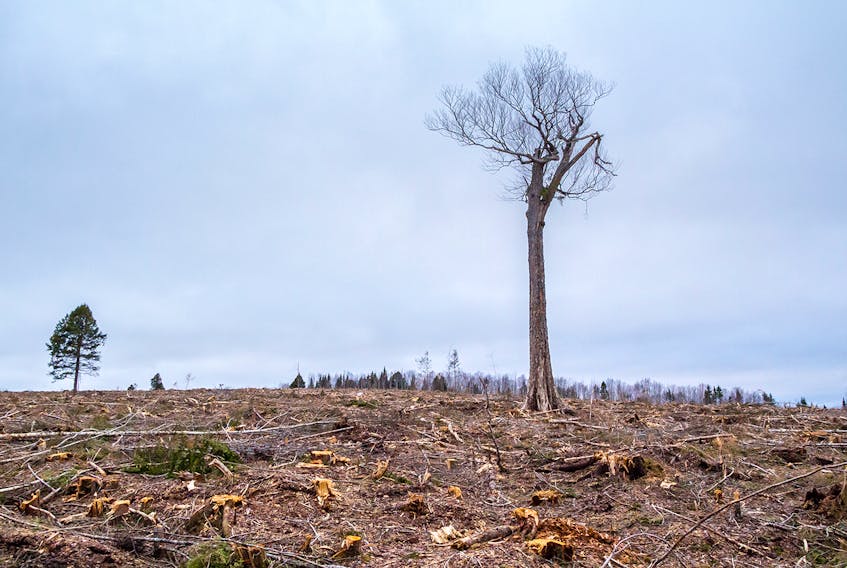ANNAPOLIS ROYAL, NS - Members of Annapolis County’s municipal council have been working hard to influence the province to shift directions in managing Nova Scotia’s forests, says the warden -- but there’s plenty more work to be done.
“Our forestry committee has been working at this topic really, really hard,” said Timothy Habinski as he described what council’s committee is doing.
Councillor Gregory Heming chairs the forestry committee with councilors Mike Gunn, Burt McNeil, and John MacDonald exploring particular avenues such as Mi’kmaq bands and their perspectives, mapping, and trying to get a better sense exactly where and to what extent clear cutting has been deployed through Annapolis County.
And, said Habinski, they want to know what pieces of land it is most incumbent upon the county to try to find ways to protect.
The committee presented a preliminary report to council’s committee of the whole meeting recently, asking for council’s approval to conduct a couple of days of sessions with industry experts who would come in and provide advice for the county.
“They’re going to talk about forestry practices and what they’ve seen specifically in our own municipality because you want to insure that whatever we develop as a recommendation for a way forward is based on evidence and expertise as opposed to whim,” said Habinski.
First Goal
The warden said the first goal of the committee is to produce a plan for a municipally owned forest governed by best practices.
“We think it’s important to put our money where our mouth is,” he said. “It’s not enough to just ask the province to change what they’re doing. We want to show exactly how we think it is in the best interests of our constituents to have our forests managed – for biodiversity, for carbon capture, for the value of the timber itself and the future of the forestry industry.”
He said none of those things are at odds with each other.
“That’s the big thing that’s becoming really, really clear – they are not at odds. You get higher quality timber and a more lucrative forestry industry if you have better management practices in place,” he said. “The same practices that leave the forests with the necessary biodiversity to support your ecosystem, that leave your forests with the capacity to scrub carbon from the atmosphere in significant amounts. So the interests of those who want to preserve the forests and the interests of those who want to monetize the forests are marching hand in hand. It’s a single resource that we exhibit stewardship over for all of these reasons simultaneously.”
Habinski said the county wants to do a demonstration of a community forest on municipally owned land.
Best Practices Approach
“We’ll be putting forward a proposal that we would respectfully request the province would consider for a best practices approach to forest management for the entirety of Annapolis County, based, again, on evidence and expertise,” he said. “And finally I think we’ll be putting forward a proposal to the province, or a request to the province, to consider adopting a different approach to cap and trade in order to incentivize better forestry practices. Give woodlot owners financial incentive to keep the forest standing and growing in its value and retaining its biodiversity and its function in the ecosystem.”
He said sometimes woodlot owners are forced to sell or clear cut when they are in dire financial straits.
“Your only option sometimes is to sell off a third of your forest or have it clear cut. And once it’s done you’ll never see the value from that land again as long as you own that piece of property,” he said. “The overall value of what you have as a resource declines and diminishes. They would like an alternative.”
He believes many woodlot owners wouldn’t clear cut if there was a way for them to obtain an annual financial dividend for the carbon function of their standing forest.
State of Forestry
The warden hopes the county’s concerns won’t be lost on the province that is currently studying the state of forestry in Nova Scotia.
The province is undertaking an independent review of forest practices in Nova Scotia with King’s College president Bill Lahey as project lead for the review. His mandate was to provide his report to Natural Resources Minister Margaret Miller by the end of February but that mandate was been extended until the end of April.
The review is examining current practices, including strengths and weaknesses, and will provide recommendations for improvement regarding how Nova Scotia balances long-term environmental, social, and economic interests in managing the province's forests, the department said on its website. In particular, the review has the mandate to examine the following components:
-- Evaluate the effectiveness and identify opportunities to improve the legislation, regulations, policies and guidelines, as well as the science-based tools that determine whether and where harvesting occurs, as well as the harvesting methods -- clear cut, partial harvest, etc. -- that can or should be used.
-- Evaluate market access for private forest owners, particularly in the western region, and provide recommendations to address any identified issues.
Met with Lehey
“Back in November we had a meeting with the representatives from the forestry committee – myself and our CAO had a meeting with Bill Lahey,” said Habinski. “We wanted to talk about some of the concerns that we had here in Annapolis County. We wanted to insure they were on the province’s radar as they were in the process of doing their own forestry review. We also wanted them to have an idea of where it was that we were going, what we wanted to see.”
He said Lahey was quite receptive.
“It was a very pleasant meeting, but we were also aware at the end of the meeting that a lot of the onus for work in order to drive a change was going to be on us,” he said. “That if we wanted the province to shift directions, we had to demonstrate really in concrete terms why it was necessary, and put our own shoulders to the wheel to push alongside the province.”
Last year the county asked the province to exclude Annapolis County from the terms of a then-pending contract with WestFor for a period of one year. The county wanted to see the contract and wanted time to see what the contract meant and its implications for Annapolis County.
The contract would have given WestFor unprecedented authority over crown forests in a county where 14 per cent of land is crown forest.
Annapolis County council’s request was turned down -- twice.








